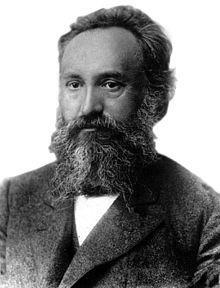Evgraf Fedorov | |
|---|---|
 Evgraf Stepanovich Fedorov | |
| Born | 22 December 1853 |
| Died | 21 May 1919 (aged 65) |
| Known for | Fedorov groups Fedorov's theorem |
Evgraf Stepanovich Fedorov (Russian: Евгра́ф Степа́нович Фёдоров, 22 December [O.S. 10 December] 1853 – 21 May 1919) was a Russian mathematician, crystallographer and mineralogist.[1][2][3]
Fedorov was born in the Russian city of Orenburg. His father was a topographical engineer. The family later moved to Saint Petersburg. From the age of fifteen, he was deeply interested in the theory of polytopes, which later became his main research interest. He was a distinguished graduate of the Gorny Institute, which he joined at the age of 26. He was elected the first Director of the Institute in 1905.[4]
He contributed to the identification of conditions under which a group of Euclidean motions must have a translational subgroup whose vectors span the Euclidean space. He undertook investigations into crystal structure as early as 1881.[5] His best-known result is his 1891 derivation of the 230 symmetry space groups which now serve as the mathematical basis of structural analysis. He also proved that there are only 17 possible wallpaper groups which can tile a Euclidean plane.[6] This was then proved independently by George Pólya in 1924.[7] The proof that the list of wallpaper groups was complete only came after the much harder case of space groups had been settled. In 1895, he became a professor of geology at the Moscow Agricultural Institute (now the Timiryazev Academy). Fedorov died from pneumonia in 1919 during the Russian Civil War in Petrograd, RSFSR.
He developed the Fedorov stage for polarizing microscopes, a tool for crystallography which allows a mineral specimen to be studied under precise angles of tilt and rotation, providing an analysis of crystal structure.[8]
- ^ I. I. Shafranovskii and N. V. Belov, "In Memoriam: E. S. Fedorov 1853–1919," in P. P. Ewald, ed., Fifty Years of X-ray Diffraction (Utrecht, Nederland: International Union of Crystallography, 1962), pages 341–350. PDF online
- ^ R.V. Galiulin (November 2003) "To the 150th anniversary of the birth of Evgraf Stepanovich Federov (1853–1919): Irregularities in the fate of the theory of regularity," Crystallography Reports, 48 (6) : 899–913. PDF online
- ^ A. Meniailov, "Fyodorov (or Fedorov), Evgraf Stepanovich" in Charles C. Gillispie, editor in chief, Dictionary of Scientific Biography (New York, New York: Charles Scribner's Sons, 1972), vol. 5, pp. 210–214.
- ^ Biggart, John; John, King (1998). "Profiles of Russian scientists and philosophers". Alexander Boganov and the Origins of Systems Thinking in Russia.
- ^ See:
- Fedorov, E.S. (1882). "§ 55. Е.С. Федоровъ сообщилъ свои изслѣдованія о приложеніи нѣкоторыхъ законовъ геометріи къ разъяснію образованія двойниковыхъ кристалловъ" [§ 55. E.S. Fedorov reported his research on the application of certain laws of geometry to explain the formation of twin crystals.]. Записки Императорского С.-Петербургского Минералогического Общества (Zapiski Imperatorskova Sankt-Petersburgskova Mineralogicheskova Obshchestva, Proceedings of the Imperial St. Petersburg Mineralogical Society). 2nd series (in Russian). 17: 381.
- Fedorov, E.S. (1883). "§ 62. Е.С. Федоровъ, новторивъ вкратцѣ сущность изложенной имъ годъ тому назадъ теорія кристаллической структуры, по которой элементарныа кристаллическія сферы имѣютъ формы параллоедровъ (три-, тетра-, гекса-, гептапараллоедры) и плоскости которыхъ суть двойниковыя плоскости кристалловъ, приступилъ къ изложенію продолженія своихъ изслѣдованій" [§ 62. E.S. Fedorov — having briefly reiterated the essence of the theory of crystalline structure presented by him a year ago, according to which the elementary crystalline spheres have the form of parallohedra (tri-, tetra-, hexa-, heptaparallohedra) and whose planes are the twin planes of the crystal — proceeded to present the continuation of his research.]. Записки Императорского С.-Петербургского Минералогического Общества (Zapiski Imperatorskova Sankt-Petersburgskova Mineralogicheskova Obshchestva, Proceedings of the Imperial St. Petersburg Mineralogical Society). 2nd series (in Russian). 18: 281.
- Fedorov, E.S. (1885). "Начала ученія о фигурахъ" [Elements of the theory of figures]. Записки Императорского С.-Петербургского Минералогического Общества (Zapiski Imperatorskova Sankt-Petersburgskova Mineralogicheskova Obshchestva, Proceedings of the Imperial St. Petersburg Mineralogical Society). 2nd series (in Russian). 21: 1–279.
- Fedorow, F. von (1892). "Zusammenstellung der kirstallographischen Resultate des Herrn Schoenflies und der meinigen" [Compilation of the crystallographic results of Mr. Schoenflies and mine]. Zeitschrift für Krystallographie und Mineralogie (in German). 20: 25–75.; see footnote on p. 26. From p. 26: "Diesem Gegenstande ist der vierte Abschnitt meiner "Elemente der Lehre von den Figuren" gewidmet, welcher schon 1881 fertig war, und in demselben Jahre habe ich davon schon Anwendung gemacht, und zwar darauf eine neue Theorie der Krytallstructur basirt (Verhandl. d. k. mineral. Ges. 17, 381 u. 18, 281)." (The fourth part of my "Elements of the Theory of Figures", which was already finished in 1881, is devoted to this subject, and in the same year, I had already made use of it, and indeed [I had] based a new theory of crystal structure on it (Proceedings of the Imperial St. Petersburg Mineralogical Society, 17, p. 381 and 18, p. 281).)
- ^ Fedorov, E.S. (1891). "Симметрія на плоскости" [Simmetriya na ploskosti, Symmetry in the plane]. Записки Императорского С.-Петербургского Минералогического Общества (Zapiski Imperatorskova Sankt-Petersburgskova Mineralogicheskova Obshchestva, Proceedings of the Imperial St. Petersburg Mineralogical Society). 2nd series (in Russian). 28: 345–390.
- ^ George Pólya (1924) "Über die Analogie der Kristallsymmetrie in der Ebene" (On the analog of crystal symmetry in the plane), Zeitschrift für Kristallographie, 60 : 278–282.
- ^ "An improved polarizing microscope IV. The Federov stage (three-axis)" (PDF). Mineralogical Magazine. 1949. Retrieved 4 September 2019.